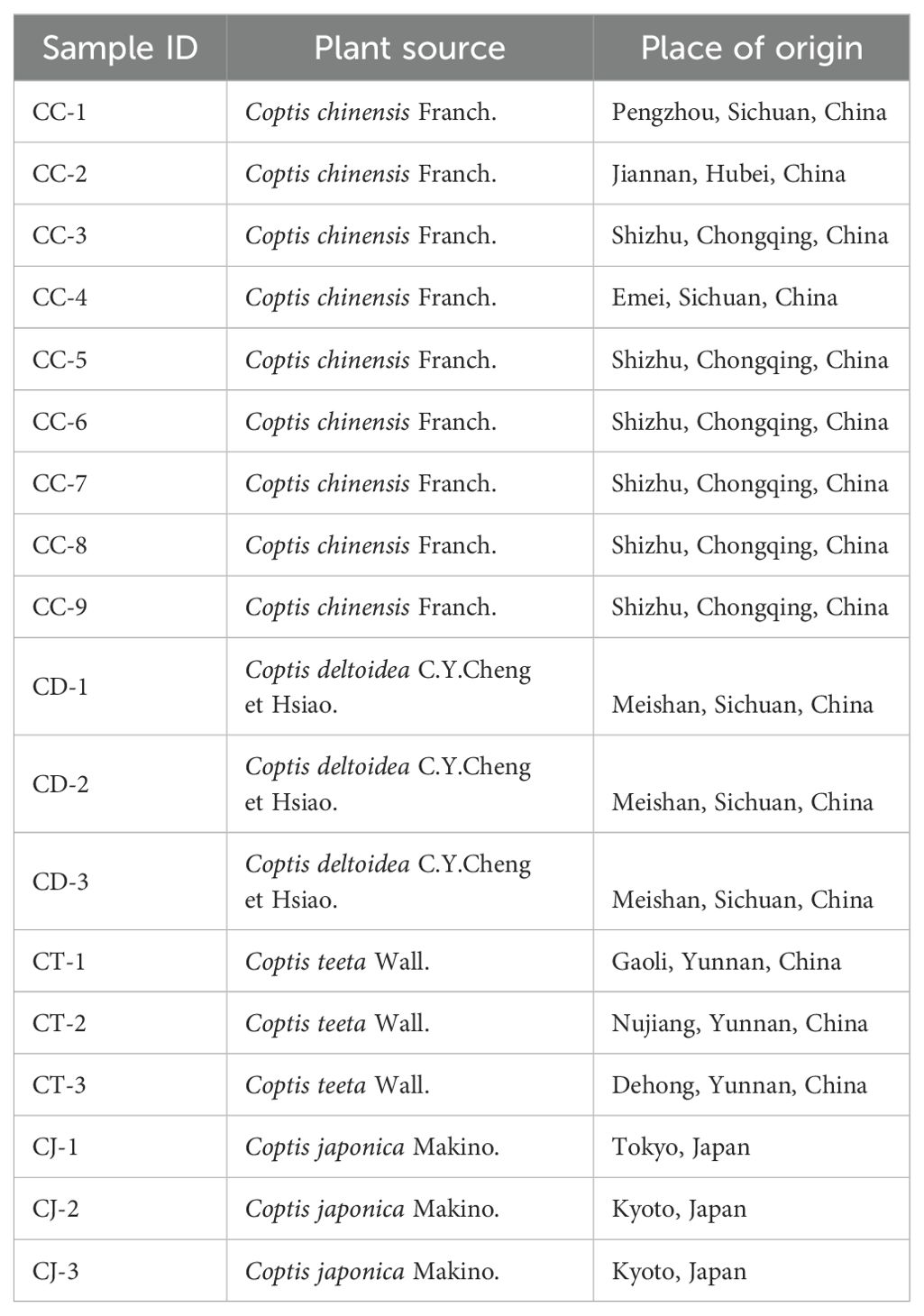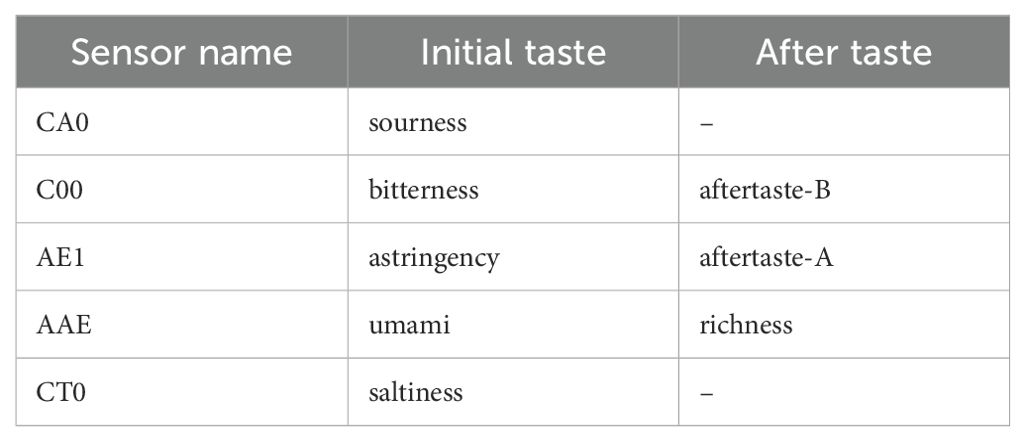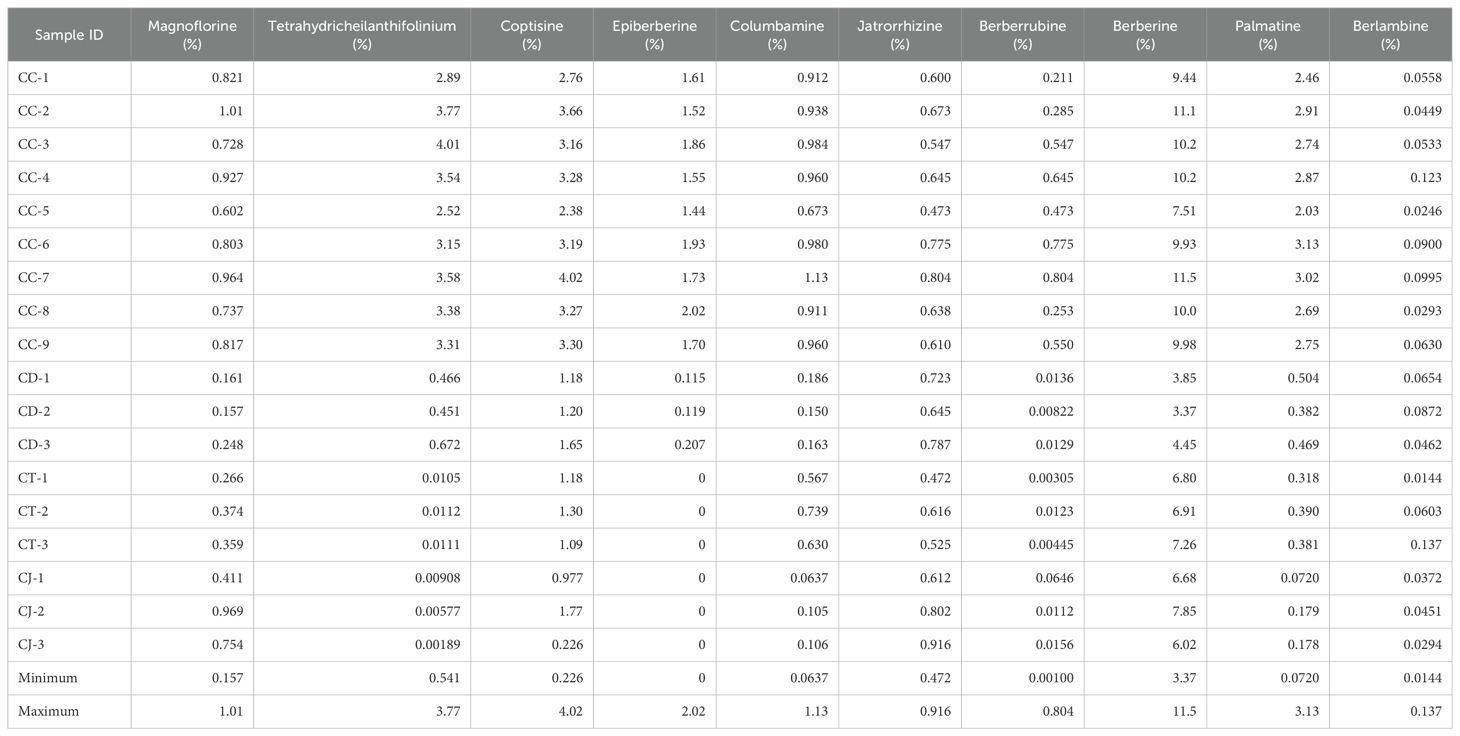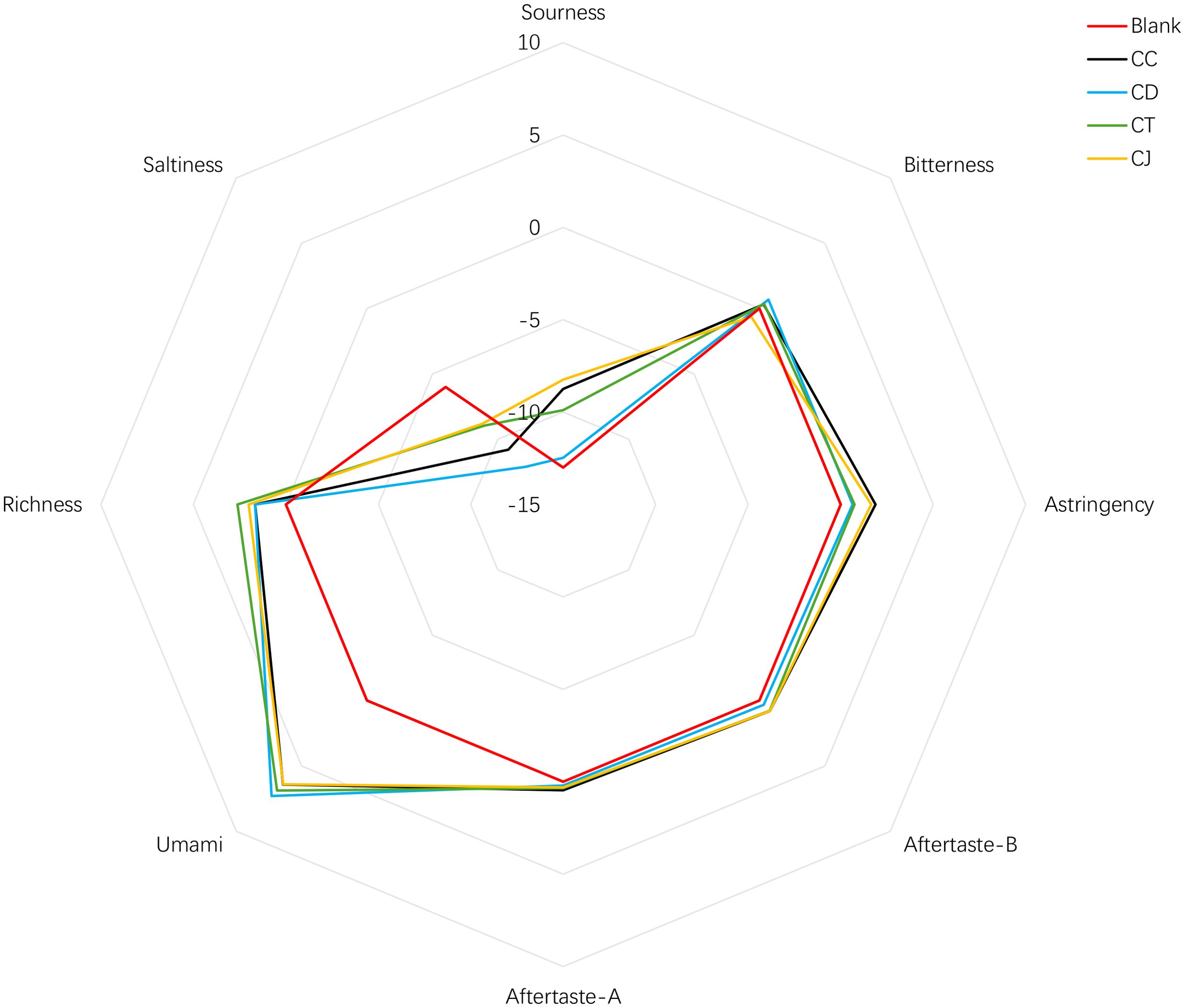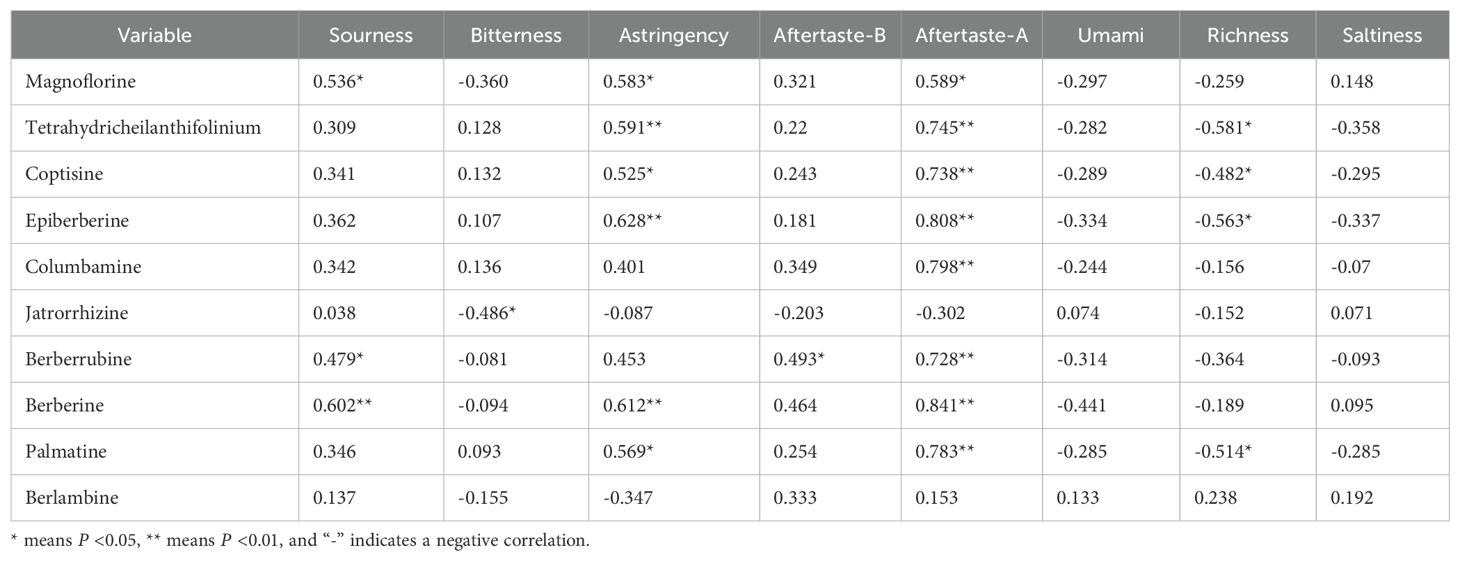- 1Guangdong Provincial Hospital of Chinese Medicine, The Second Affiliated Hospital of Guangzhou University of Chinese Medicine, Guangdong, China
- 2School of Chinese Materia Medica, Guangdong Pharmaceutical University, Guangdong, China
- 3Technique Center, Guangdong Yifang Pharmaceutical Co., Ltd, Foshan, China
- 4The Ministry of Education (MOE) Key Laboratory of Standardization of Chinese Medicines and the State Administration of Traditional Chinese Medicine (SATCM) Key Laboratory of New Resources and Quality Evaluation of Chinese Medicines, Institute of Chinese Materia Medica, Shanghai University of Traditional Chinese Medicine, Shanghai, China
Objective: Taste is one of the vital indicators for the quality evaluation of Coptis rhizome (CR), but the traditional taste evaluation lacks objectivity. By establishing the correlation between CR’s tastes and alkaloids, an objective basis for the taste evaluation was established.
Methods: Ultra-high performance liquid chromatography tandem triple quadrupole mass spectrometry (UHPLC-QQQ-MS/MS) and electronic tongue technique were performed to determine ten alkaloid contents and eight tastes from Coptis chinensis rhizome, Coptis deltoidea rhizome, Coptis teeta rhizome, and Coptis japonica rhizome, respectively. Combined with multivariate statistical analysis, we established models to discriminate the alkaloid contents and tastes of CR, screened the differential alkaloids and tastes, and performed Pearson’s correlation analysis on the results of alkaloids and tastes.
Results: 1) According to the previous UHPLC-QQQ-MS/MS method established by our research group, the contents of ten alkaloids of the four species of CR were quantified, of which jatrorrhizine, columbamine, and magnoflorine were the differential alkaloids of the four species. 2) The electronic tongue technique realized the objectification of CR’s tastes and distinguished the species of CR based on the tastes of aftertaste-A, sourness, bitterness, and richness. 3) Pearson’s correlation analysis shows the bitterness of CR was mainly manifested as aftertaste-B, indicating the higher the aftertaste-B value, the higher the berberrubine content. Astringency and aftertaste-A could be suggested as quality evaluation indexes of CR, due to the positively correlated or significantly positively correlated with coptisine, epiberberine, berberine, and palmatine, respectively.
Conclusion: Electronic tongue technique has successfully achieved the objectification of the tastes of CR, and combined with UHPLC-QQQ-MS/MS technique for alkaloid quantification and correlation research, it provides a new idea for the quality evaluation of CR.
1 Introduction
Coptis rhizome (CR) is a multi-source herbal medicine that has significant clinical use. CR is derived from the species of Coptis chinensis Franch. (CC), Coptis deltoidea C.Y. Cheng et Hsiao (CD), and Coptis teeta Wall. (CT). The rhizome of Coptis japonica Makino. (CJ) is also used as CR in the Japanese Pharmacopoeia, the Korean Pharmacopoeia, and the international standard ISO 7177:2023.
The traditional view considers the tastes of CR to be highly correlated with the quality of the herb, and “bitter taste” has been taken as the basis for the superior quality of CR. The taste of CR has also been described in several pharmacopeias, but the traditional identification of CR relies on personal experience and lacks objective quantitative indicators (Xu et al., 2016). The electronic tongue, also known as bionic taste, is an artificial taste system designed to simulate the mechanism of human taste perception. It can realize food and drug samples’ objective and quantitative taste (Wasilewski et al., 2019; Lu et al., 2022). The technology has begun to be applied in Chinese medicines, realizing the digitization and objectification of sensory evaluation of Chinese herbal medicines (Li et al., 2016; Yaroshenko et al., 2016). Liang et al. (2014) measured the bitter degree of six alkaloids isolated from Coptis chinensis rhizome using the electronic tongue technique. Still, there is a lack of objectification of CR’s other taste sensations. Therefore, the SA-402B taste analysis system used in this study can simultaneously objectify eight tastes of samples, which make up for the shortcomings of traditional taste identification methods for CR.
Alkaloids are CR’s primary pharmacological active ingredients, with effects of antibacterial action, anti-inflammation, antioxidant, antitumor, immune regulation, hypolipidemic, and hypoglycemic (Wang et al., 2019). In modern studies, quality evaluation of CR is focused chiefly on chemical compound analysis. Berberine, epiberberine, coptisine, and palmatine, as representatives of the pharmacodynamic active ingredients of CR, have been used as recognized indicators for the quality evaluation of CR (China Pharmacopoeia Commission, 2020). However, chemical analysis techniques such as high performance liquid chromatography (HPLC) and ultra-high performance liquid chromatography tandem mass spectrometry (UHPLC-MS) are complicated to operate and have high detection costs, leading to limitations in practical application (Wang P. et al., 2024). In the trend of paying more attention to the overall quality evaluation, there is a lack of correlation studies between the traditional subjective evaluation of CR (tastes) and its objective evaluation (alkaloids).
Therefore, in this study, we objectively evaluated the quantitative characterization of CR’s “taste” by the electronic tongue technique and established a digital evaluation method for the specificity of CR’s “taste”, which can succeed in species identification of CR. Then, a “taste-alkaloid” correlation analysis was carried out by combining the results of ten alkaloid contents in CR by ultra-high performance liquid chromatography tandem triple quadrupole mass spectrometry (UHPLC-QQQ-MS/MS), which provides a new idea for the quality evaluation of CR.
2 Materials and methods
2.1 Materials and reagents
A total of 18 batches of CR were obtained from four plant sources, and the specific information is shown in Table 1. Professor Xian-you Qu from Chongqing Academy of Chinese Materia Medica and senior agronomist Wei Dai from Mianyang Academy of Agricultural Sciences identified all CR samples. Chemical reference substances (CRS), such as magnoflorine, tetrahydricheilanthifolinium, coptisine, epiberberine, columbamine, jatrorrhizine, berberrubine, berberine, palmatine, berlambine (purity ≥98%, HPLC grade), were purchased from Shanghai Yuanye Bio-Technology Co., Ltd. (Shanghai, China). The HPLC-graded methanol, acetonitrile, formic acid, and other chemical reagents were obtained from Fisher Scientific (Pittsburgh, PA, USA). The water was obtained from a Milli-Q water purification system (Millipore, Bedford, MA, USA).
2.2 Preparation of reference solutions and test sample solutions
The CRS solutions were accurately weighed and dissolved in methanol. Their concentrations for working solution were as follows: magnoflorine (6.34 μg/mL), tetrahydricheilanthifolinium (5.38 μg/mL), coptisine (36.5 μg/mL), epiberberine (34.7 μg/mL), columbamine (5.82 μg/mL), jatrorrhizine (12.35 μg/mL), berberrubine (4.05 μg/ml), berberine (32.3 μg/mL), palmatine (27.3 μg/mL), berlambine (2.86 μg/mL).
Accurately weighed 0.2 g CR powder and placed it in a stoppered conical flask, accurately added 50 mL of methanol-hydrochloric acid (100: 1) solution to the flask followed by ultrasonic treatment for 30 min. Made up for the mass loss with methanol and centrifuged it. Took 2 mL of filtrate and put it into a 10 mL volumetric flask and set volume with methanol; Then, filtered through a 0.22 μm micropore membrane. The filtrate was used for liquid chromatography tandem mass spectrometry (LC-MS) analysis.
The samples used for the electronic tongue test were prepared as follows: weighed accurately 3.0 g of CR powder and placed in a conical flask, added 50 mL of ultrapure water; Extracted by ultrasonic for 30 min, then centrifuged at 4000 rpm for 5 min. The supernatant was taken for electronic tongue analysis. Potassium chloride and tartaric acid were taken as the reference solution for the electronic tongue. The response values of each sensor of the reference solution were taken as the base point. Since the reference solution contained acid and salt components, the base points for sourness and saltiness were -13 and -6, and the base points for the rest of the tastes were zero. All solutions were stored in a refrigerator at 4°C until analysis.
2.3 Apparatus and conditions of LC-MS
LC-MS analysis was performed on an Agilent 1290 series ultra-high performance liquid chromatography system tandem 6460 triple quadrupole mass spectrometer (Agilent Technologies, Santa Clara, CA, USA), which was previously reported by our team (He et al., 2022). In brief, the chromatographic separation was carried out at 30°C on a Waters Acquity UPLC CSH C18 column (2.1×100 mm, 1.7 μm, Waters, Milford, MA, USA). A mobile phase consisting of 0.1% acetic acid (A) and acetonitrile (B) in a gradient elution manner as follows: 10-14% B at 0-3 min, 14-16% B at 3-9 min, 16-25% B at 9-13 min, 25-80% B at 13-14 min, 80% B at 14-16 min. The sample injection volume was 2 μL, and the flow rate was 0.35 mL/min. Mass detection was performed on an electrospray ionization (ESI) source. The mass spectrum was chosen in positive mode, and the mass spectra were acquired in multiple reaction monitoring (MRM) mode. The drying gas (N2) flow rate was 11.0 L/min; the drying gas temperature was 300°C; the nebulizer was 15 psig, and the capillary voltage was 4000 V. The parent ion, daughter ion, fragment voltage, and collision energy were adjusted to obtain the highest abundance of each analyte. The method validation was investigated according to the Chinese Pharmacopoeia (China Pharmacopoeia Commission, 2020), and the results met the requirement of sample chemical analysis.
2.4 Apparatus and conditions of electronic tongue
SA-402B taste analysis system (Intelligent Sensor Technology, Inc., Japan) was adopted to evaluate the taste characteristics of CR in this study. It contained five taste sensors (Table 2) and two reference electrodes (Ag/AgCl).
The electronic tongue was activated, calibrated, and equilibrated to the available conditions; then samples were measured according to the recently reported method (Wang JW. et al., 2024). Briefly, the electronic tongue sensor determined the membrane potential of each sample, collecting one data per second for 30 s with a stirring rate of 1 r/s. It was washed in the reference solution for 3 s and inserted into a new reference solution to test the retort for 30 s. Each sample was measured in parallel four times and analyzed.
The precision of the instrument was investigated. The test solution of sample CC-1 was taken, and the sample was repeated five times using the electronic tongue to measure the response value of each sensor and calculate the relative standard deviation (RSD). The RSD of each sensor response value was less than 2.0%, indicating good precision of the instrument.
2.5 Statistical analysis
The results of tastes and alkaloid contents of CR were subjected to orthogonal partial least squares discriminant analysis (OPLS-DA) as well as cluster analysis using SIMCA 18.0 software (Umetrics AB, Umea, Sweden). Pearson’s correlation analysis between the taste values and alkaloid contents of CR was performed by the Scientific Platform Serving for Statistics Professional (SPSSPRO) platform (Scientific Platform Serving for Statistics Professional, 2021).
3 Results
3.1 LC-MS analysis of CR
The UHPLC-QQQ-MS/MS method successfully determined the contents of ten alkaloids in eighteen batches of CRs from four species. The chromatograms of the samples are shown in (Figure 1), and the content results are shown in Table 3. Epiberberine was not found in CRs derived from CT and CJ. Berberine is the alkaloid with the highest average content (7.95 ± 2.42%) in all CR samples.
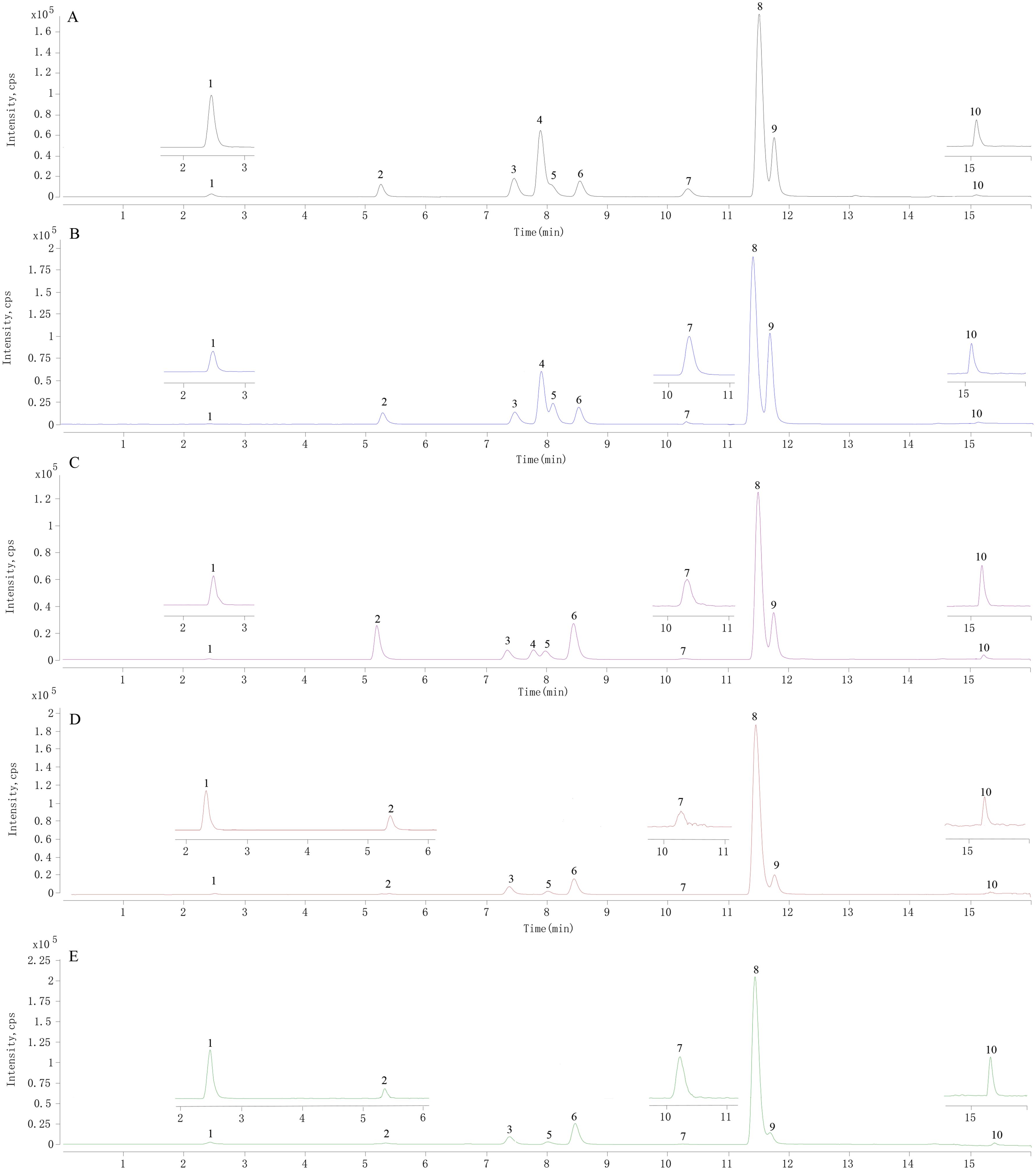
Figure 1. The representative MRM chromatograms of mixed reference solution and samples of Coptis rhizome. (A) mixed reference solution, (B) test solution of Coptis chinensis rhizome, (C) test solution of Coptis deltoidea rhizome, (D) test solution of Coptis teeta rhizome, and (E) test solution of Coptis japonica rhizome. 1. magnoflorine, 2. tetrahydricheilanthifolinium, 3. coptisine, 4. epiberberine, 5. columbamine, 6. jatrorrhizine, 7. berberrubine, 8. berberine, 9. palmatine, 10. berlambine.
3.2 Taste analysis of CR
The five sensors of the SA-402B taste analysis system successfully detected eight tastes in 18 batches of CR samples. The taste indices of CR are achieved through quantification and visualization (Figure 2). There were differences in the different taste values for CR. Umami, sourness, and richness were the tastes with CR’s top three response values. The mean value of saltiness for all samples, as well as that of bitterness for CJ, was below the no-taste point of the sensor response value. Unfortunately, the radar chart (Figure 2) cannot distinguish well among the different species of CR, which needs to be further analyzed by statistical methods.
3.3 OPLS-DA for CR
The OPLS-DA of tastes and alkaloid contents for CR were well performed by SIMCA 18.0 software, respectively. Figures 3A, C show that the taste results determined by the electronic tongue can successfully differentiate four species of CR (R2X 0.928, R2Y 0.78, Q2 0.395). Aftertaste-astringency (aftertaste-A), sourness, bitterness, and richness played the key roles (VIP >1). As well as, Figures 3B, D show that the alkaloid contents of CR determined by UHPLC-QQQ-MS/MS can also be used to differentiate CR from the four species (R2X 0.928, R2Y 0.671, Q2 0.57), with jatrorrhizine, columbamine, and magnoflorine playing the key roles (VIP >1).
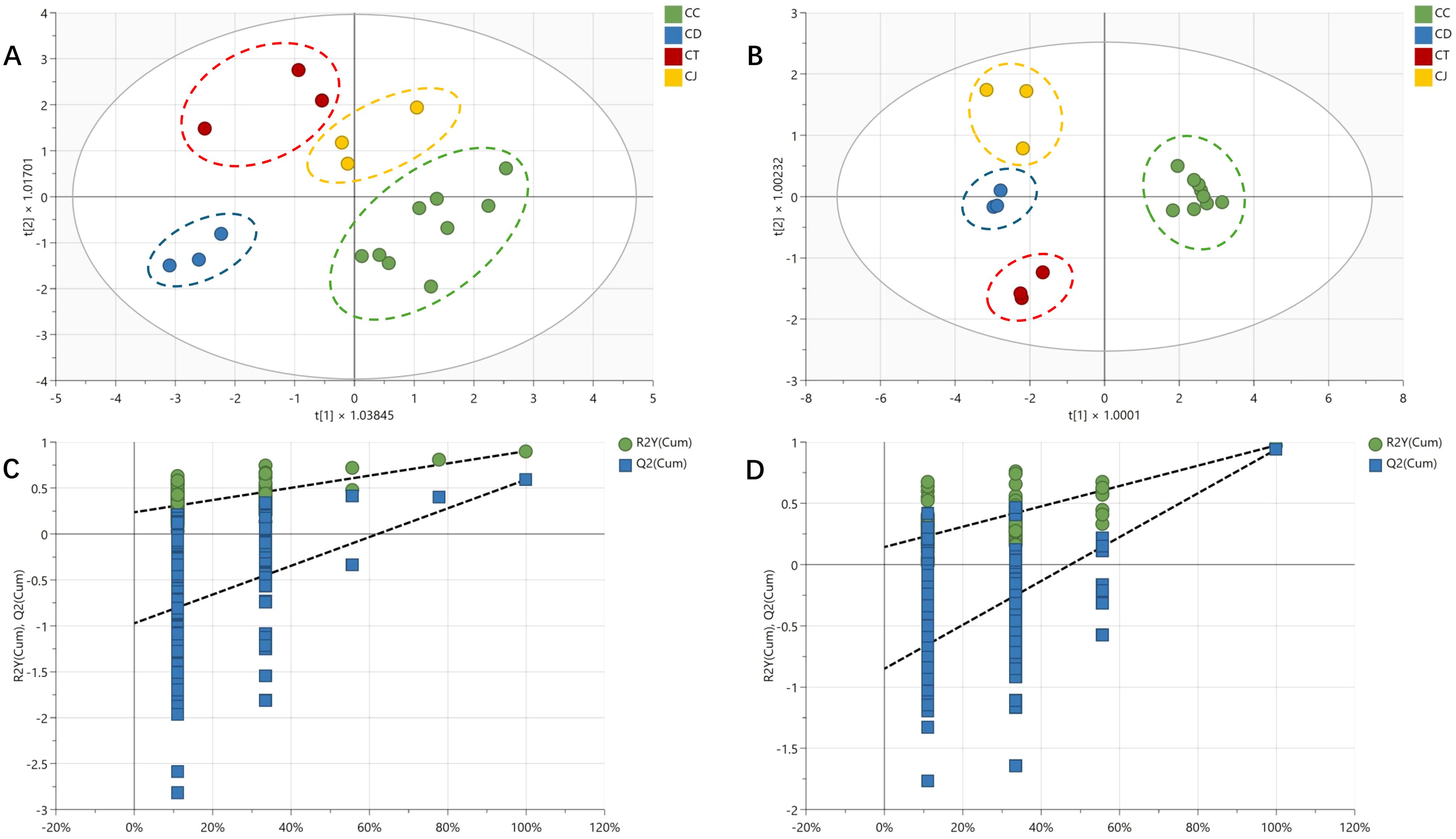
Figure 3. The OPLS-DA model diagram of tastes and alkaloid contents for Coptis rhizome. (A) core scatter plot of tastes; (B) core scatter plot of alkaloid contents; (C) correlation plot between original Y-vector and permuted Y-vector of tastes; (D) correlation plot between original Y-vector and permuted Y-vector of alkaloid contents.
3.4 Hierarchical cluster analysis for CR
A hierarchical cluster analysis of tastes and alkaloid contents for CR was performed by SIMCA 18.0 software, respectively. HCA result shows that the taste results (Figure 4A) and alkaloid contents (Figure 4B) successfully distinguished the four groups, respectively. The grouping results were consistent with those of CR species, which was the same as the results of Clause 3.3.

Figure 4. The dendrogram of hierarchical cluster analysis according to the tastes (A) and alkaloid contents (B) for CR.
3.5 Correlation analysis of tastes and alkaloids for CR
Pearson’s correlation analysis of tastes and alkaloid contents for CR was carried out using the SPSSRO platform, and a significant correlation was observed in the results in Table 4. Uncommonly, the bitterness of CR was negatively correlated with jatrorrhizine (P <0.05), while aftertaste-bitterness (aftertaste-B) was positively correlated with berberrubine (P <0.05). The results suggested that the bitterness of CR was mainly manifested as aftertaste-B, indicating the higher the aftertaste-B value, the higher the berberrubine content. In addition, astringency was positively correlated with coptisine and palmatine (P <0.05) and significantly positively correlated with epiberberine and berberine (P <0.01); meanwhile, aftertaste-A was significantly positively correlated with coptisine, epiberberine, berberine, and palmatine (P <0.01), suggesting that astringency and aftertaste-A could be used as quality evaluation indexes of CR. Moreover, saltiness did not correlate with alkaloids, which is consistent with the saltiness result of the electronic tongue in CR.
4 Discussion
The technology of taste evaluation based on the material has highlighted the characteristics of traditional Chinese medicine modernization. This study found that the electronic tongue technique can be used as a new method to evaluate the quality of CR, consistent with previous research opinions (Ran et al., 2024). The electronic tongue can realize the objectification and visualization of taste indicators, which has the advantage of faster and more convenient operation than the LC-MS method. In addition to CR, there are a variety of Chinese medicine applications of electronic tongue research reports, such as Schisandrae Chinensis fruit (Wang L. et al., 2024), Rheum root and rhizome (Liu et al., 2024), and Bletilla striata rhizome (Li H. et al., 2024), etc.
CR is a multi-source herbal medicine, suggesting that treating them differently in quality evaluation is necessary. However, the clinical and pharmaceutical enterprises’ use of CR decoction pieces does not distinguish from which species, and the real-world view is that their effects are the same. According to the results of electronic tongue and mass spectrometry detection, there are differences among the four kinds of CR. Uniformly, OPLS-DA and HCA showed that taste values and alkaloid contents could distinguish CR from different plant sources. These findings are consistent with the quality requirements of CR in the Chinese Pharmacopoeia; that is, the alkaloid types and content requirements corresponding to different species of CR are different. Further correlation analysis showed a correlation between tastes and alkaloid contents in CR. In particular, the chemical markers, such as coptisine, epiberberine, berberine, and palmatine, for the quality evaluation of CR are associated with CR’ tastes (aftertaste-A, astringency, aftertaste-B) a positive correlation or significant positive correlation, which addressed the lack of correlation study between the CR’s specific alkaloid types and the electronic tongue characterization of “bitter taste” in the previous study (Zhang et al., 2017).
In the theory of traditional Chinese medicine, the “five tastes” of Chinese medicines represent their authentic taste and, on the other hand, represent some of the effects. CR is a bitter Chinese medicine. It has the traditional functions of clearing heat, draining fire, and drying dampness. It shows the modern pharmacological effects, such as anti-inflammation and anti-diarrhea (Li C. et al., 2024; Hu et al., 2024). The traditional view is that the more bitter the taste of CR, the better its quality. This study’s results also confirm that the higher the aftertaste-B value of CR, the higher the content of berberrubine in CR. It has been reported that the total alkaloids of CR inhibited the PI3K-AKT pathway and reduced inflammation by activating PPARγ (Li J. et al., 2024). Berberine alleviates intestinal inflammation in mice by improving endoplasmic reticulum stress (Yarmohammadi et al., 2022) and immunomodulatory effects (Li et al., 2020). It is speculated that higher aftertaste-B and higher content of specific alkaloids have better anti-inflammatory effects. In this study, we analyzed the correlation between the tastes of CR and its alkaloids, which are the representatives of the pharmacodynamic activity of CR. Therefore, through the axis of taste-alkaloid-pharmacological activity of CR, the author proposed a preliminary and predictive conclusion between the taste and pharmacological effect of CR. Of course, more experiments are needed to verify it at the next step.
5 Conclusion
In this study, the electronic tongue technique was successfully used to achieve the objective evaluation of CR taste, and it can also be used to distinguish CR from different plant sources. In combination with LC-MS results, the correlation between tastes and alkaloids was established, which provided a new idea for the quality evaluation of CR. However, due to resource protection, the number of CD, CT, and CJ samples is small, which leads to limitations on the research results.
Data availability statement
The raw data supporting the conclusions of this article will be made available by the authors, without undue reservation.
Author contributions
YH: Funding acquisition, Investigation, Writing – original draft, Formal analysis, Visualization. WL: Data curation, Validation, Writing – review & editing. WP: Methodology, Writing – review & editing. DS: Conceptualization, Writing – review & editing. HZ: Project administration, Supervision, Writing – review & editing. FH: Funding acquisition, Project administration, Supervision, Writing – review & editing, Visualization.
Funding
The author(s) declare financial support was received for the research, authorship, and/or publication of this article. This project was funded by the National Natural Science Foundation of China (82374139) and the Guangdong Provincial Bureau of Traditional Chinese Medicine Research Project (20241149).
Acknowledgments
The authors would like to thank senior agronomist Wei Dai from Mianyang Academy of Agricultural Sciences and Prof. Xianyou Qu from Chongqing Academy of Chinese Materia Medica for their kind assistance in collecting samples.
Conflict of interest
Authors WL and DS were employed by Guangdong Yifang Pharmaceutical Co., Ltd.
The remaining authors declare that the research was conducted in the absence of any commercial or financial relationships that could be construed as a potential conflict of interest.
Publisher’s note
All claims expressed in this article are solely those of the authors and do not necessarily represent those of their affiliated organizations, or those of the publisher, the editors and the reviewers. Any product that may be evaluated in this article, or claim that may be made by its manufacturer, is not guaranteed or endorsed by the publisher.
References
China Pharmacopoeia Commission (2020). Pharmacopoeia of the People’s Republic of China, (2020, Part 1) (Beijing: Chinese Medicines and Technology Press).
He, F., Huang, Y. F., Dai, W., Qu, X. Y., Lu, J. G., Lao, C. C., et al. (2022). The localization of the alkaloids in Coptis chinensis rhizome by time-of-flight secondary ion mass spectrometry. Front. Plant Sci. 13, 1092643. doi: 10.3389/fpls.2022.1092643
Hu, C., Cao, F., Jiang, Y., Liu, K., Li, T., Gao, Y., et al. (2024). Molecular insights into chronic atrophic gastritis treatment: Coptis chinensis Franch studied via network pharmacology, molecular dynamics simulation and experimental analysis. Comput. Biol. Med. 178, 108804. doi: 10.1016/j.compbiomed.2024.108804
Li, C., Deng, L., Pu, M., Ye, X., Lu, Q. (2024). Coptisine alleviates colitis through modulating gut microbiota and inhibiting TXNIP/NLRP3 inflammasome. J. Ethnopharmacol. 335, 118680. doi: 10.1016/j.jep.2024.118680
Li, H., Feng, C., Fan, C., Yang, Y., Yang, X., Lu, H., et al. (2020). Intervention of oncostatin M-driven mucosal inflammation by berberine exerts therapeutic property in chronic ulcerative colitis. Cell Death Dis. 11, 271. doi: 10.1038/s41419-020-2470-8
Li, H., Wang, P. P., Lin, Z. Z., Wang, Y. L., Gui, X. J., Fan, X. H., et al. (2024). Identification of Bletilla striata and related decoction pieces: a data fusion method combining electronic nose, electronic tongue, electronic eye, and high-performance liquid chromatography data. Front. Chem. 11. doi: 10.3389/fchem.2023.1342311
Li, J., Ma, Z., Yang, Z., Yang, M., Li, C., Li, M., et al. (2024). Integrating transcriptomics and network pharmacology to reveal the mechanisms of total Rhizoma Coptidis alkaloids against nonalcoholic steatohepatitis. J. Ethnopharmacol. 322, 117600. doi: 10.1016/j.jep.2023.117600
Li, X., Gao, X., Liu, R., Wang, J., Wu, Z., Zhang, L., et al. (2016). Optimization and validation of the protocol used to analyze the taste of traditional Chinese medicines using an electronic tongue. Exp. Ther. Med. 12, 2949–2957. doi: 10.3892/etm.2016.3733
Liang, X. G., Wu, F., Wang, Y. J., Fu, Z., Wang, Y., Feng, Y., et al. (2014). Research on bitter components from Coptis chinensis based on electronic tongue. Zhongguo Zhong Yao Za Zhi. 39, 3326–3329.
Liu, T., Yu, M., Dai, Y., Xiao, Y., Li, L. (2024). Traditional method of rhubarb processing optimized by combining flavor analysis with anthraquinone content determination. Front. Nutr. 11. doi: 10.3389/fnut.2024.1406430
Lu, L., Hu, Z., Hu, X., Li, D., Tian, S. (2022). Electronic tongue and electronic nose for food quality and safety. Food Res. Int. 162, 112214. doi: 10.1016/j.foodres.2022.112214
Ran, J. C., Yoshimitsu, M., Qin, W. H., Yang, Y., Shu, Z. M., Zhang, X. M.. (2024). Study on the digitalization and grade of the odor of Coptis chinensis produced in Shizhu. West China J. Pharm. Sci. 39, 58–64. doi: 10.13375/j.cnki.wcjps.2024.01.012
Scientific Platform Serving for Statistics Professional (2021). SPSSPRO. (Version 1.0.11). Available online at: https://www.spsspro.com (Accessed August 15, 2024).
Wang, P., Gui, X., Xu, M., Dong, F., Li, Y., Wang, Q., et al. (2024). In vivo and in vitro chemical composition and biological activity of traditional vs. dispensing granule decoctions of Coptidis Rhizoma: A comparative study. BioMed. Chromatogr. 38, e5960. doi: 10.1002/bmc.5960
Wang, L., Liu, K., Wu, T., Chen, X., Chen, Y., Yue, C., et al. (2024). Effective strategy for distinguishing raw and vinegar Schisandrae Chinensis Fructus based on electronic eye and electronic tongue combined with chemometrics. Phytochem. Anal. doi: 10.1002/pca.3427
Wang, J. W., Pei, Z. D., Chen, Y. H., Li, S. Y., Wang, T. M., Kang, T. G., et al. (2024). A strategy to distinguish similar traditional Chinese medicines by liquid chromatography-mass spectrometry, electronic senses, and gas chromatography-ion mobility spectrometry: Marsdeniae tenacissimae Caulis and Paederiae scandens Caulis as examples. Phytochem. Anal. doi: 10.1002/pca.3425
Wang, J., Wang, L., Lou, G. H., Zeng, H. R., Hu, J., Huang, Q. W., et al. (2019). Coptidis Rhizoma: a comprehensive review of its traditional uses, botany, phytochemistry, pharmacology and toxicology. Pharm. Biol. 57, 193–225. doi: 10.1080/13880209.2019.1577466
Wasilewski, T., Migoń, D., Gębicki, J., Kamysz, W. (2019). Critical review of electronic nose and tongue instruments prospects in pharmaceutical analysis. Anal. Chim. Acta 1077, 14–29. doi: 10.1016/j.aca.2019.05.024
Xu, M. F., Wu, Z. S., Liu, X. N., Shi, X. Y., Qiao, Y. J. (2016). Quality evaluation method for Chinese medicine based on color grading. Zhongguo Zhong Yao Za Zhi. 41, 177–181. doi: 10.4268/cjcmm20160204
Yarmohammadi, F., Hayes, A. W., Karimi, G. (2022). The therapeutic effects of berberine against different diseases: A review on the involvement of the endoplasmic reticulum stress. Phytother. Res. 36, 3215–3231. doi: 10.1002/ptr.7539
Yaroshenko, I., Kirsanov, D., Kartsova, L., Sidorova, A., Sun, Q., Wan, H., et al. (2016). Exploring bitterness of traditional Chinese medicine samples by potentiometric electronic tongue and by capillary electrophoresis and liquid chromatography coupled to U.V. detection. Talanta 152, 105–111. doi: 10.1016/j.talanta.2016.01.058
Keywords: Coptis rhizome, electronic tongue, bitterness, UHPLC-QqQ-MS/MS, berberine, quality evaluation
Citation: Huang Y, Luo W, Pei W, Sun D, Zhou H and He F (2024) Study on the correlation between alkaloids and tastes of Coptis Rhizome from four species based on UHPLC-QQQ-MS/MS combined with electronic tongue technique. Front. Plant Sci. 15:1496789. doi: 10.3389/fpls.2024.1496789
Received: 15 September 2024; Accepted: 16 October 2024;
Published: 07 November 2024.
Edited by:
Peng Zhu, Wannan Medical College, ChinaReviewed by:
Biao Qu, Macau University of Science and Technology, ChinaJiaoyang Luo, Chinese Academy of Medical Sciences and Peking Union Medical College, China
Hua Luo, University of Macau, China
Copyright © 2024 Huang, Luo, Pei, Sun, Zhou and He. This is an open-access article distributed under the terms of the Creative Commons Attribution License (CC BY). The use, distribution or reproduction in other forums is permitted, provided the original author(s) and the copyright owner(s) are credited and that the original publication in this journal is cited, in accordance with accepted academic practice. No use, distribution or reproduction is permitted which does not comply with these terms.
*Correspondence: Fan He, bmlzYWhlQDEyNi5jb20=; Hua Zhou, Z3V0Y216aHNAaG90bWFpbC5jb20=
†These authors have contributed equally to this work
 Yufeng Huang
Yufeng Huang Wenhui Luo2,3†
Wenhui Luo2,3† Wenhan Pei
Wenhan Pei Hua Zhou
Hua Zhou Fan He
Fan He